|

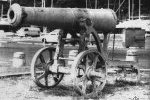 CRIMEAN CANNONS - WHERE ARE THEY NOW?
CRIMEAN CANNONS - WHERE ARE THEY NOW?
Army Memorial Museum, Waiouru.
Ankara Yacht Club, Aukland
North Island
New Zealand
Even far-flung colonies such as New Zealand were included in the handout of these 'trophies'. Two SBML 18-pr Russian Cannon were presented to the New Zealand Government, which proudly displayed them at Auckland. One resides now at the Akarana Yatch Club in Auckland (see picture right) and another in the Army Memorial Museum, Waiouru (see picture below)
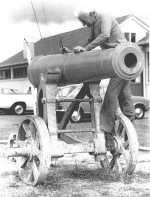 The guns are trophies from the Crimean War (1854-56). Historians well know the war as one badly managed. Also to the chagrin of the British Government it was one in which the media were able to present the facts to the British public, who, to put the matter politely, were not amused. As a propaganda cover-up, i.e. to justify the dilatory progress made during the siege of Sebastopol which led to the troops suffering severe hardships and casualties from cold, hunger and disease - as well as battle casualties - the British Government removed a substantial number of pieces of ordnance from the fortress, distributed them throughout the Empire, and ensured they were prominently displayed with appropriate captions. The implication of course was that having to face such an enormous number of guns made the siege last so long. They did not bother to inform the populace that as well as a fortress Sebastopol was an ordnance depot and a dumping ground for numerous unserviceable and obsolete guns dating back to the previous century. Nor did they state that the actual fortress armament consisted of a mere 173 pieces to which a handful had been added during the siege.
The guns are trophies from the Crimean War (1854-56). Historians well know the war as one badly managed. Also to the chagrin of the British Government it was one in which the media were able to present the facts to the British public, who, to put the matter politely, were not amused. As a propaganda cover-up, i.e. to justify the dilatory progress made during the siege of Sebastopol which led to the troops suffering severe hardships and casualties from cold, hunger and disease - as well as battle casualties - the British Government removed a substantial number of pieces of ordnance from the fortress, distributed them throughout the Empire, and ensured they were prominently displayed with appropriate captions. The implication of course was that having to face such an enormous number of guns made the siege last so long. They did not bother to inform the populace that as well as a fortress Sebastopol was an ordnance depot and a dumping ground for numerous unserviceable and obsolete guns dating back to the previous century. Nor did they state that the actual fortress armament consisted of a mere 173 pieces to which a handful had been added during the siege.
At first glance the Waiouru gun appears similar in construction to a standard British 18-pr of the same period except that it is about a foot (30 cm) shorter. That the piece shows few signs of corrosion after over 170 years exposed to the elements shows that the cast iron of which it was made was of excellent quality. The calibre measured across the muzzle is 5.375 inches, and slightly more measured vertically, indicating some wear from firing. Taking into account wear plus corrosion the original calibre must have been very close to that of the British 18-pr, i.e. 5.292 inches (134.4 mm).
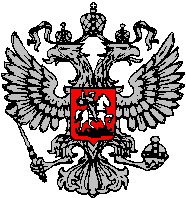 On the second reinforce appears in relief the Imperial Russian Coat of Arms, a double-headed and spread Royal Eagle, on the breast of which are depicted the figures of Saint George and the Dragon. (See picture right) Markings on the piece in the Russian language are in the Cyrillic alphabet with the exception of numerals, which are the same as in use by Western nations.
On the second reinforce appears in relief the Imperial Russian Coat of Arms, a double-headed and spread Royal Eagle, on the breast of which are depicted the figures of Saint George and the Dragon. (See picture right) Markings on the piece in the Russian language are in the Cyrillic alphabet with the exception of numerals, which are the same as in use by Western nations.
On the breech above the cascable appear the letters 'MA' incised into the metal. They stand for MORSKAYA ARTILLERIA = Marine Artillery, the initial letters of which just happen to coincide with the English equivalents.
The cascable appears to have been bored and threaded for the fitting of an elevating screw but it is now plugged and connected to the carriage by a chain to prevent the gun from being elevated or depressed. To keep the gun horizontal a pillar has been fixed under the breech. Two holes in the vent field on the breech indicate the gun was once fitted with a lock of some kind.
Trunnion markings, left and right respectively:
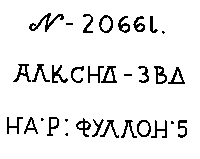 LEFT TRUNNION:
LEFT TRUNNION:
(See picture) -'18 -' stands for '18 fun', the 'fun' being the Russian pound, which was almost the same as the pound avoir dupois used in Britain. '88-' = '88 pood' the latter being equal to 35 fun, i.e. the weight of the piece is 88 x 35 = 3080 pounds (Lbs) or 1400 kg. '1825' is the date of manufacture of the piece. The meaning of 'I' is not understood.
 RIGHT TRUNNION:
RIGHT TRUNNION:
(See picture) - 'N- 20661' is the register number, No 20661. '' transcribed is 'ALKSND - ZVD' an abbreviated form of 'ALEKSANDREVSKY ZAVODA' which means 'Alexander Factory', bottom line, the place of manufacture, the middle word, transcribes to 'FULLON' the director of the factory. The meaning of the other symbols and '5' are not known.
SIGHTS:
Laying appears to have been 'by eye' using the horizontal line on the muzzle and a similar one on the breech. No sights are fitted.
PERFORMANCE:
No data are available. Being about a foot shorter than its British counterpart it was probably less efficient. The British 18-pr achieved 1800 yards (1646 m) at 5 degrees elevation. Effective range of either would not have exceeded 1000 yards as the hitting power of round shot fell off rapidly at the longer ranges.
CARRIAGE:
The carriage, which is entirely of iron, is known as the 'rear chock type', the rear portion of which ran in some kind of guide while the complete carriage recoiled up a sloping platform to absorb recoil energy. Gravity brought the carriage back to the runout position assisted if necessary by handspikes applied to the protruding axles.
HISTORY:
After having been delivered to Auckland in the late 1850s the two Russian guns were placed outside the Albert Barracks until 1871 when the area became Albert Park. Near the end of the century they were placed in front of the park flagstaff together with other historic artillery pieces. There they stood until 1941.
Following Japan's entry into the war late that year certain local citizens prevailed upon the City Council to get the guns out of sight. These people feared, so they said, that the Japanese might mistake the collection of ancient relics for modern armament and bomb the area. The city fathers took the easy way out; they proceeded to bury the guns on the spot, mutilating them in the process. Although there stood the Auckland War Memorial Museum no more than a stone's throw away, no one thought of placing the guns there.
Fortunately the Sebastopol guns escaped the ignominious burial suffered by the others. The Commodore, Royal Akarana Yacht Club, the late Mr E. Edgecumbe, realising their historical significance, persuaded the Auckland City Council to give them to the Club. On 30 December 1941 they were placed one on either side of the RAYC flagstaff. Clearly Mr Edgecumbe was a better judge of Japanese intelligence than the City Council. On 23 October 1979 the Army suggested the RAYC might release one of the guns to the Queen Elizabeth II Army Memorial Museum in return for restoration work on the other. The Club agreed - with one proviso, that they have it back for their centenary in 1994.
Restoration became a joint effort by Army and Navy; workmen at HMNZ Dockyard Devonport sandblasted both pieces under the watchful eye of the late A.J. (Alf) Smith who ensured the workmen 'went easy' on the Coats of Arms and other markings on the pieces. RNZEME personnel at 1 Field Workshop, Papakura, then painted both equipments.
Much of the research into the history and markings on the guns was carried out by S Sgt C.J. (Colin) Andrews RNZE (now retired) then stationed at Land Force Headquarters, Takapuna. Assisting him were the late J.T. (Terry) Transom and W.L. Ruffell both then members of the NZ Military Historical Society. All those mentioned in this paper also were or still are members of the NZPFOCA.
THE RUSSIAN STORY:
During the period leading up to the Crimean War Russian ordnance was largely produced under the direction of Western Europeans. The Alexander Factory, located at Petrozavodsk on Lake Onega, was a French concern until 1777 when it went bankrupt and was taken over by the State, which appointed Andre Fullon, an ex-director, to manage it.
Around 1779 Charles Gascoigne of the Scottish Carron works had a disagreement with the firm over credit for invention of the carronade and emigrated to Russia, taking several skilled workmen with him. He directed the Alexander Factory from 1786 to 1806. Adam Armstrong was in charge from 1806 to 1818 when Alexander Fullon (son of Andre) took over. Adam's son Ivan directed the factory from 1833 to 1843 when he was replaced by Butyenev, a Russian.
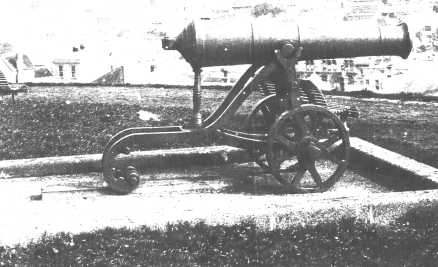
Above: One of the two Russian guns presented to New Zealand. Photo taken in Albert Park, Auckland, around 1900.
The gun remaining in Auckland, also an 18-pr, was made in a second factory, the Lugniska (Lugansk) situated in the southern Ukraine and directed by a German named Nielus. The names of the directors quoted figure frequently on the Sebastopol 'trophies' which date from 1794 to 1852.
Source: W L Ruffell.
The Original Location of the Two Cannon:
Once the Albert barracks had been cleared away in the mid-1870s, the City Improvement Commissioners and the Auckland City Council looked to what could be done to create a beautiful park in the midst of the city. On an elevated area overlooking Coburg (later Kitchener) Street, Victoria Street East, and Bowen Avenue, a series of three flower-decorated terraces were proposed, crowned by a 75-feet high flagstaff and set off with big guns pointing toward the said streets. (Star, 5 March 1881) The first of the collection were Russian cannon from the Crimean War and the battle of Sebastopol. They were placed one on each side of the flagstaff.
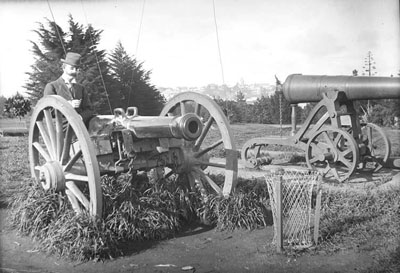
The picture right circa 1900, appears to show the Crimean Cannon on the right and is one of the few pictures that we have been able to locate. The thin white cables to the left suggest it might be near the flagstaff mentioned above.
ADDITIONAL INFORMATION

CONSTRAINTS
On private property, Open set times only
LANDSCAPE
City Centre
REGION
Located outside the United Kingdom
THE FEATURES PRESENT
Crimean Cannon Location, past or present
|









